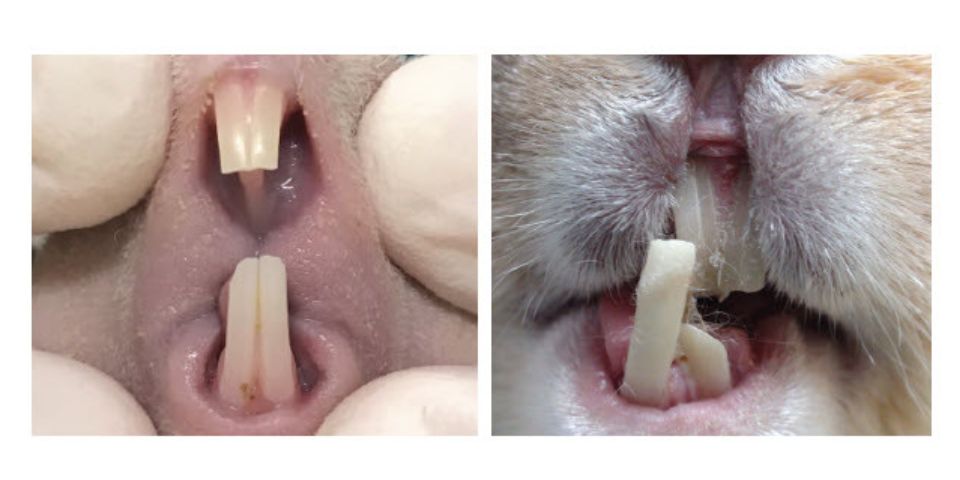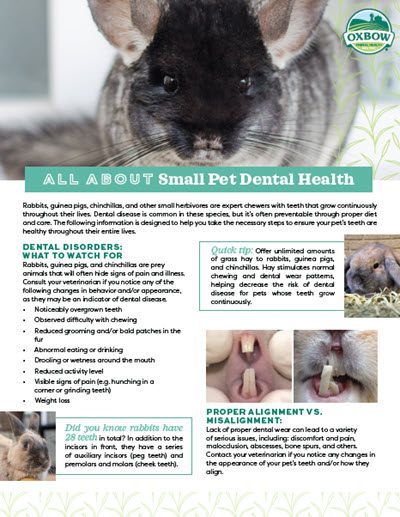Updated: May 5, 2023
Rabbits, guinea pigs, chinchillas, and other small herbivores are expert chewers with teeth that grow continuously throughout their lives. Dental disease is common in these species, but it’s often preventable through proper diet and care. The following information is designed to help you take the necessary steps to ensure your pet’s teeth are healthy throughout their entire lives.
In this article, we’ll cover the following important topics:
- Signs of dental disease in small pets
- Proper dental alignment vs. misalignment
- Hay and your pet’s dental health
- Top five tips for managing dental health
Signs Of Dental Disease In Small Pets
Rabbits, guinea pigs, and chinchillas are prey animals that will often hide signs of pain and illness. Consult your veterinarian if you notice any of the following changes in behavior and/or appearance, as they may be an indicator of dental disease.
Signs of dental disease in small pets may include:
- Noticeably overgrown teeth
- Observed difficulty with chewing
- Reduced grooming and/or bald patches in the fur
- Abnormal eating or drinking
- Drooling or wetness around the mouth
- Reduced activity level
- Visible signs of pain (e.g. hunching in a corner or grinding teeth)
- Weight loss
 Proper Alignment Vs. Misalignment
Proper Alignment Vs. Misalignment
Lack of adequate dental wear can lead to a variety of serious issues for your pet. These issues can include:
- Discomfort and pain
- Malocclusion
- Abscesses
- Bone Spurs
Contact your veterinarian if you notice any changes in the appearance of your pet’s teeth and/or how they align.
 Hay & Your Pet’s Dental Health
Hay & Your Pet’s Dental Health
- Grass hay is the ideal, high fiber material to provide healthy dental wear
- Eating hay facilitates the natural “side to side” chewing motion of small herbivores
- Offer a variety of grass hays to encourage consumption & prevent picky eating
Quick Tip:
Offer unlimited amounts of grass hay to your rabbit, guinea pig, or chinchilla. Hay stimulates normal chewing and dental wear patterns, helping decrease the risk of dental disease.
 Top Five Tips For Managing Small Animal Dental Health
Top Five Tips For Managing Small Animal Dental Health
Schedule regular veterinary checkups
Don’t overfeed pellets or treats
Regularly offer natural chews
Feed unlimited amounts of hay
Pay close attention to your pet
1. Schedule Regular Veterinary Checkups
Your pet should visit the veterinarian at least once a year (twice is even better) for a checkup. Your vet will assess your pet’s dental health during this visit, and it’s a great opportunity to ask any questions you have about your pet’s teeth.
2. Don’t Overfeed Pellets or Treats
Pellets are an important part of your pet’s daily nutrition, but overfeeding them can limit your pet’s interest in hay. Always follow feeding recommendations on pellets and treats.
3. Regularly Offer Safe, Enriching Natural Chews
Chew toys made with woven hay, untreated wood, apple sticks, and other natural materials are great for helping keep your pet’s teeth healthy. Offer multiple chews regularly to keep your pet engaged.
4. Feed Unlimited Amounts of Hay
Hay is the ideal high-fiber material to provide healthy dental wear for your pet’s constantly growing teeth. Offer multiple varieties of hay to prevent picky eating tendencies that can lead to dental disorders over time.
5. Pay Close Attention To Your Pet
Observe your pet every day and make notes of any changes to his or her appearance, behaviors, and health. If you’re ever concerned about the way your pet is acting, be sure to consult your veterinarian right away.

